Discover 35 hidden attractions, cool sights, and unusual things to do in Tulsa (United States). Don't miss out on these must-see attractions: Philbrook Museum of Art, BOK Center, and Cox Business Convention Center. Also, be sure to include Gilcrease Museum in your itinerary.
Below, you can find the list of the most amazing places you should visit in Tulsa (Oklahoma).
Table of Contents
Philbrook Museum of Art
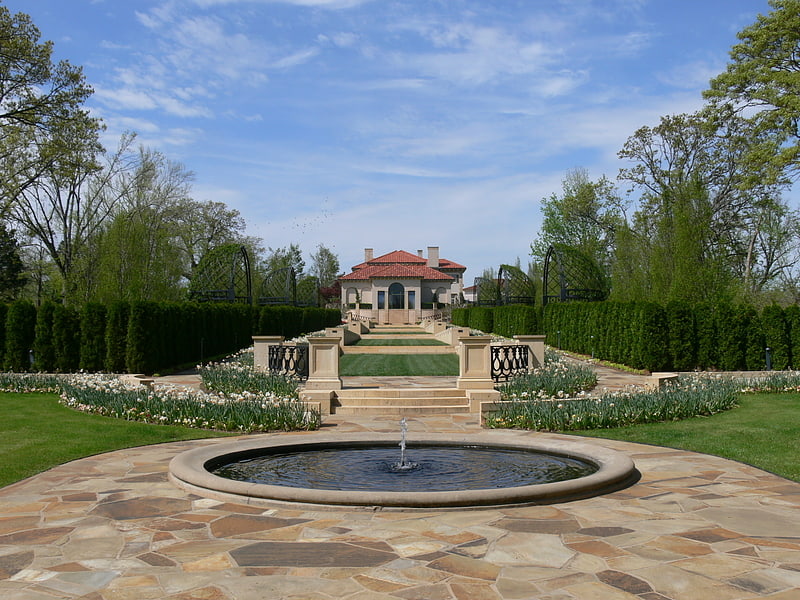
Museum in Tulsa, Oklahoma. Philbrook Museum of Art is an art museum with expansive formal gardens located in Tulsa, Oklahoma. The museum, which opened in 1939, is located in a former 1920s villa, "Villa Philbrook", the home of Oklahoma oil pioneer Waite Phillips and his wife Genevieve. Showcasing nine collections of art from all over the world, and spanning various artistic media and styles, the cornerstone collection focuses on Native American art featuring basketry, pottery, paintings and jewelry.[1]
Address: 2727 S Rockford Rd, 74114-4104 Tulsa (Midtown)
BOK Center
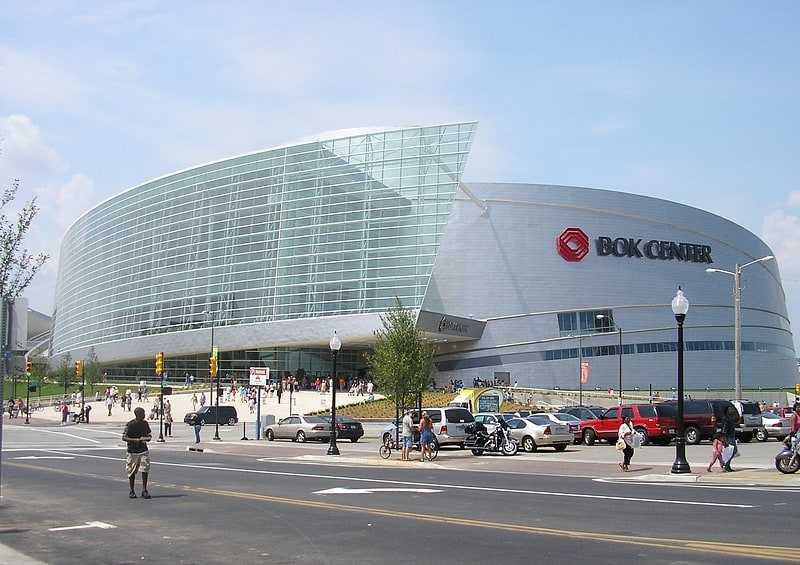
Arena in Tulsa, Oklahoma. The BOK Center, or Bank of Oklahoma Center, is a 19,199-seat multi-purpose arena and a primary indoor sports and event venue in Tulsa, Oklahoma, United States. Designed to accommodate arena football, hockey, basketball, concerts, and similar events, the facility was built at a cost of $178 million in public funds and $18 million in privately funded upgrades. Ground was broken on August 31, 2005 and a ribbon-cutting ceremony took place on August 30, 2008.
Designed by César Pelli, the architect of the Petronas Towers in Malaysia, the BOK Center is the flagship project of Tulsa County's Vision 2025 long-range development initiative. Local firm, Matrix Architects Engineers Planners, Inc, is the architect and engineer of record. The arena is managed and operated by SMG and named for the Bank of Oklahoma, which purchased naming rights for $11 million. The only current permanent tenant is the Tulsa Oilers of the ECHL. The BOK Center was the former home of the Tulsa Shock of the Women's National Basketball Association and the Tulsa Talons of the Arena Football League.[2]
Address: Tulsa, 200 South Denver Avenue West
Cox Business Convention Center
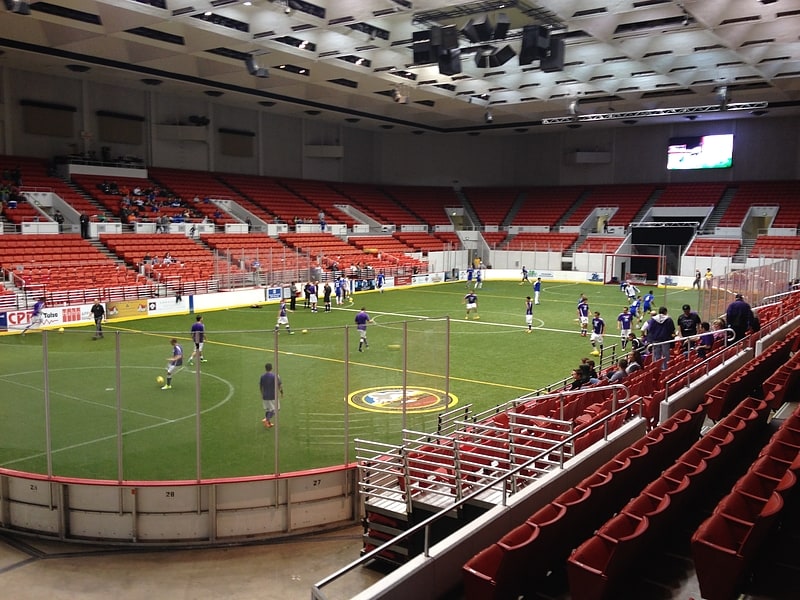
Convention center in Tulsa, Oklahoma. The Cox Business Convention Center is a 310,625 square foot convention center located in downtown Tulsa, Oklahoma.
The Cox Business Convention Center (CBCC) was originally named Tulsa Assembly Center. It was later renamed Maxwell Convention Center after former mayor James L. Maxwell.
In February 2013, Cox Communications acquired the naming rights to the facility, and renamed it the Cox Business Center, to sync with their Cox Business brand. In 2020, "Convention" was added to the name.[3]
Address: 100 Civic Ctr, 74103-3855 Tulsa
Gilcrease Museum

Museum in Tulsa, Oklahoma. Gilcrease Museum, also known as the Thomas Gilcrease Institute of American History and Art, is a museum northwest of downtown Tulsa, Oklahoma housing the world's largest, most comprehensive collection of art of the American West, as well as a growing collection of art and artifacts from Central and South America. The museum is named for Thomas Gilcrease, an oil man and avid art collector, who began the collection. He deeded the collection, as well as the building and property, to the City of Tulsa in 1958. Since July 1, 2008, Gilcrease Museum has been managed by a public-private partnership of the City of Tulsa and the University of Tulsa. The Helmerich Center for American Research at Gilcrease Museum was added in 2014 at a cost of $14 million to provide a secure archival area where researchers can access any of the more than 100,000 books, documents, maps and unpublished materials that have been acquired by the museum.[4]
Address: 1400 N Gilcrease Museum Rd, 74127-2100 Tulsa (Northside)
Boston Avenue United Methodist Church
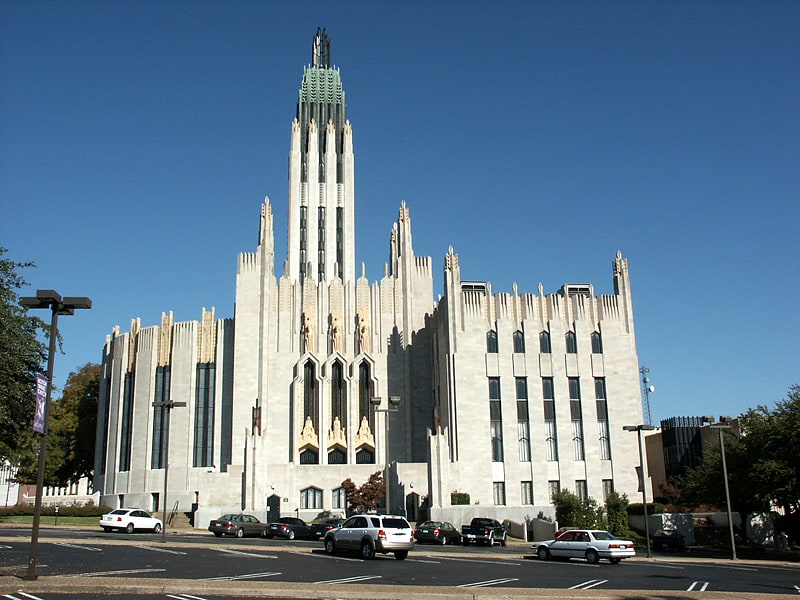
United methodist church in Tulsa, Oklahoma. The Boston Avenue United Methodist Church, located in downtown Tulsa, Oklahoma, and completed in 1929, is considered to be one of the finest examples of ecclesiastical Art Deco architecture in the United States, and has been placed on the National Register of Historic Places. Built by a congregation of the Methodist Episcopal Church, South, it was designated a National Historic Landmark in 1999. It has 15 floors.[5]
Address: 1301 S Boston Ave, 74119-3205 Tulsa
ONEOK Field

Stadium in Tulsa, Oklahoma. Oneok Field is a baseball park in Tulsa, Oklahoma. Located in the historic Greenwood district adjacent to downtown Tulsa, it is the home of the Tulsa Drillers of the Double-A Central. The stadium is named for Oneok.
Oneok Field has also been the home of FC Tulsa of the USL Championship since 2015.[6]
Address: 201 N Elgin Ave, 74120-1434 Tulsa
Cain's Ballroom
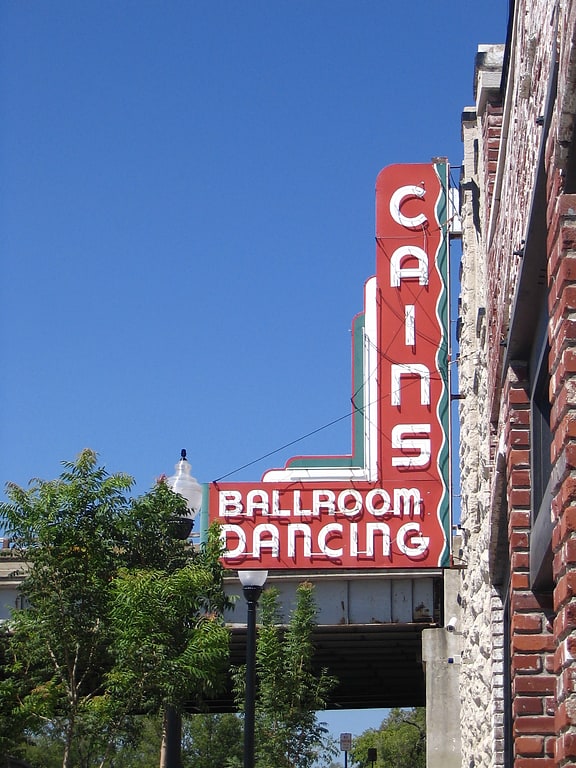
Music venue in Tulsa, Oklahoma. Cain's Ballroom is a historic music venue in Tulsa, Oklahoma that was built in 1924 as a garage for W. Tate Brady's automobiles. Madison W. "Daddy" Cain purchased the building in 1930 and named it Cain's Dance Academy.
In 2010, Pollstar ranked Cain's Ballroom at #26 worldwide for ticket sales at club venues.
The venue played a prominent role in the development of western swing in the 1930s and 1940s, when Bob Wills and the Texas Playboys would broadcast a near-daily show and perform live weekly.[7]
Address: Tulsa, 423 North Main Street
Woodward Park
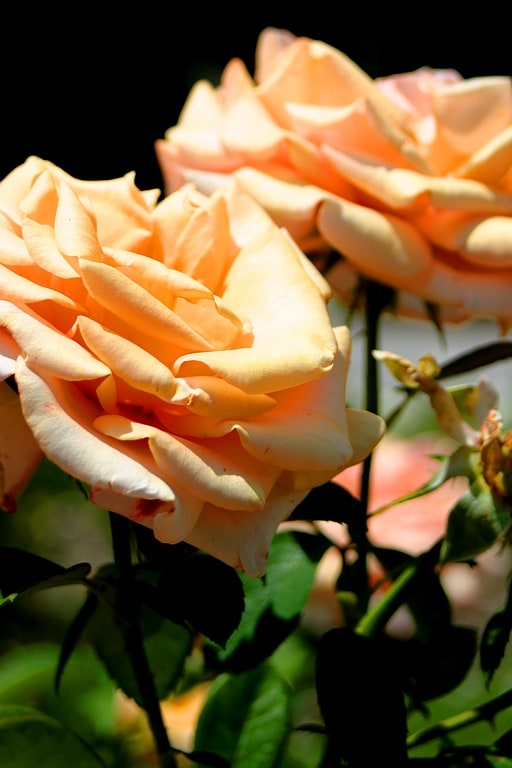
Park in Tulsa, Oklahoma. Woodward Park is a 45-acre public park, botanical garden, and arboretum located between 21st Street and 24th Street east of South Peoria Avenue and west of South Rockford Street in Tulsa, Oklahoma, in the Midwestern United States. The park, named for Helen Woodward, the original property owner, was established in 1929, after a lengthy court suit over ownership.
The park was designed to provide its visitors experience with a variety of horticultural subjects. It contains a number of specialty gardens, including those featuring spring flowers, tropical plants and cacti, the Tulsa Rose Garden, the Tulsa Garden Center, and the Tulsa Arboretum. The park is particularly known for its azaleas, as well as tulips, irises, dogwoods, and redbuds. The Rose Garden (established 1935) features over 9,000 roses of over 250 varieties.
The park was added to the National Register of Historic Places on March 11, 2014 as Woodward Park and Gardens Historic District. Its areas of significance are listed as Landscape Architecture, Architecture, and Education/Recreation.[8]
Address: 2324 S. Rockford, 74114 Tulsa (Midtown)
Holy Family Cathedral
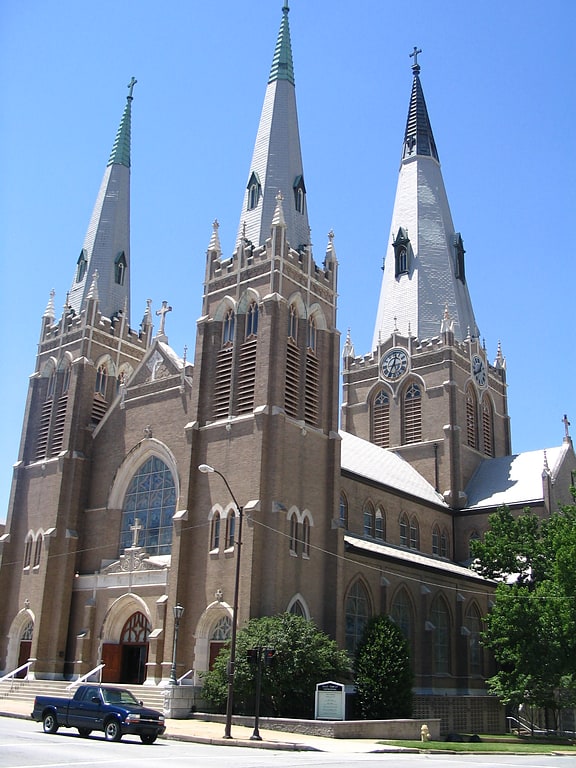
Cathedral in Tulsa, Oklahoma. The Cathedral of the Holy Family is a cathedral of the Roman Catholic Church in the United States. It is the mother church of the Diocese of Tulsa and is the seat of the bishop. It is located at 810 South Boulder Avenue in the city of Tulsa in the state of Oklahoma. The parish chose architect J.P. Curtin of the Tulsa firm Curtin, Winkler, and Macdonald to design the church. Curtin was chosen over architect William P. Ginther of Akron, Ohio, who built many Roman Catholic churches throughout the Midwest. Ginther designed an alternate plan for the church trustees who had concerns about Curtin's design. All that remains of Ginther's work is a set of blueprints.
Construction on the current structure began May 23, 1912 and Mass dedicating the church was on April 1, 1914. It was the tallest building in Tulsa until the Mayo Hotel was built in 1923. The Cathedral is also the site of the Holy Family Cathedral School, an educational institution for students from pre-school to eighth grade.
The Diocese of Tulsa was established in 1973. Buildings at this site were listed on the National Register of Historic Places February 11, 1982. The NRIS number is 82003704.[9]
Address: 122 W 8th St, 74119-1402 Tulsa
Tulsa Performing Arts Center
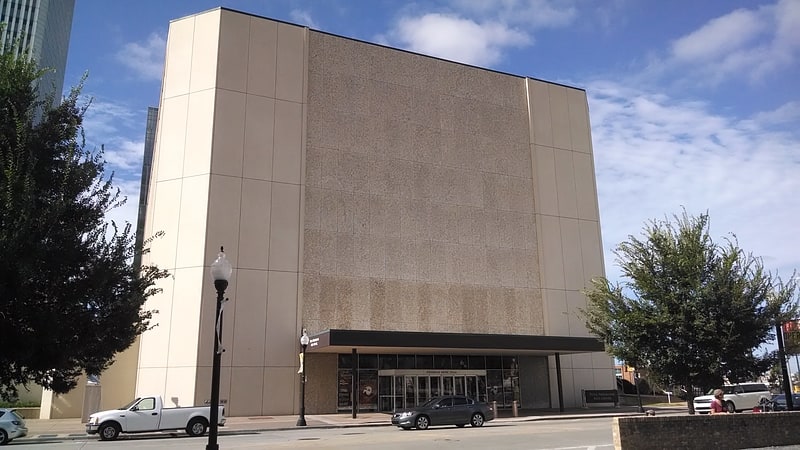
Theatre in Tulsa, Oklahoma. The Tulsa Performing Arts Center, or Tulsa PAC, is a performing arts venue in the city of Tulsa, Oklahoma. It houses four main theatres, a studio space, an art gallery and a sizeable reception hall. Its largest theater is the 2,365-seat Chapman Music Hall. The Center regularly hosts events by 14 local performance groups. Tulsa Ballet, Tulsa Opera, Tulsa Symphony, and Celebrity Attractions are among the Tulsa PAC's major clients. Tulsa Town Hall, Chamber Music Tulsa, Theatre Tulsa, American Theatre Company, Theatre Pops, Playhouse Tulsa, Theatre North, and the PAC Trust also fill the PAC calendar.
Numerous headliners such as Michael Bublé, Kelly Clarkson, Steve Martin and Anthony Bourdain have appeared at the Tulsa Performing Arts Center. The complex was built with a combination of public and private funds and opened in 1977. The building is home to a permanent collection of 76 works of art.
The Tulsa Performing Arts Center launched a regional ticketing company, run by the Tulsa PAC, in 2006. MyTicketOffice.com handles the ticketing for 12 performance arts venues in Oklahoma and Texas.[10]
Address: Tulsa, 110 E 2nd St.
Mabee Center
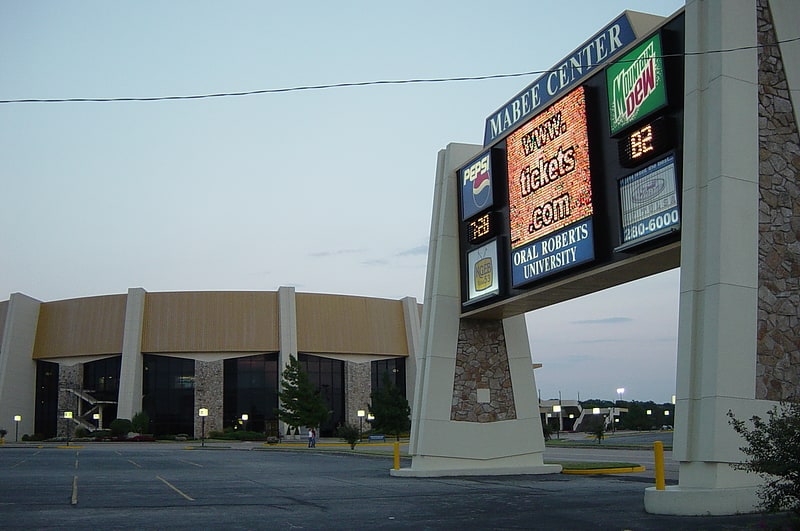
Arena in Tulsa, Oklahoma. Mabee Center is an 11,300-seat multi-purpose arena, located on the campus of Oral Roberts University, in Tulsa, Oklahoma, United States. The building opened in 1972 and was designed by architect Frank Wallace, who designed most of the buildings on the ORU campus. It carries the name of Tulsa oilman John Mabee, whose foundation donated $1 million toward its construction.
An adjacent building, smaller but similar in shape, is known as "Baby Mabee" and houses a television production studio.
Mabee Center opened in 1972 and has hosted the NAIA national men's basketball championship (1994–1998), five NCAA men's first-round or regional tournaments (1974, 1975, 1978, 1982, 1985) and the Midwestern City Conference (now Horizon League) men's basketball conference tournaments (1982, 1985).
It is home to the Oral Roberts Golden Eagles men's and women's basketball teams. It was Eastern Oklahoma's largest arena until the BOK Center was built.
A soundboard recording made at the venue of Elvis Presley's first tour show of 1974, from March 1, was recently released as part of the Follow That Dream release, "Elvis - Sold Out!".[11]
Address: 8100 S Lewis Ave, 74137-1207 Tulsa (Southside)
Skelly Field at H. A. Chapman Stadium
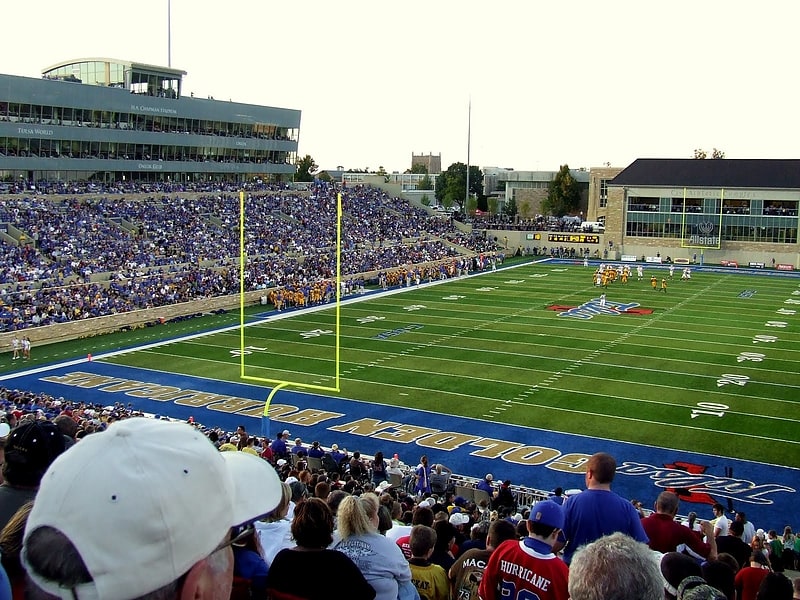
Stadium in Tulsa, Oklahoma. Skelly Field at H. A. Chapman Stadium is an outdoor football stadium located on the campus of the University of Tulsa in Tulsa, Oklahoma. Commonly known as H. A. Chapman Stadium, it is the home field for the University of Tulsa Golden Hurricane of the American Athletic Conference. The venue opened in 1930 and currently seats around 30,000 fans for football, since renovation completed in 2008.[12]
Address: 3112 E. 8th St., 74104 Tulsa (Midtown)
Tulsa Air and Space Museum
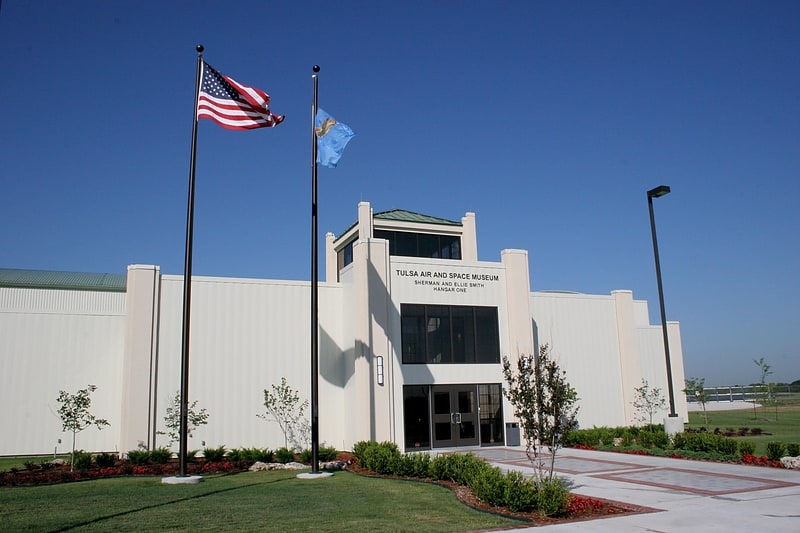
The Tulsa Air and Space Museum is an aerospace museum in Tulsa, Oklahoma, United States. It is located in the northwest corner of the Tulsa International Airport property. It has 19,000 square feet of historical exhibits, hands-on activities, and vintage aircraft. A full-dome planetarium was added in 2006. The museum also has educational facilities for school visits, summer camps, and Scout groups.[13]
Address: 3624 N 74th E Ave, 74115-3622 Tulsa (Northside)
Oklahoma Jazz Hall of Fame
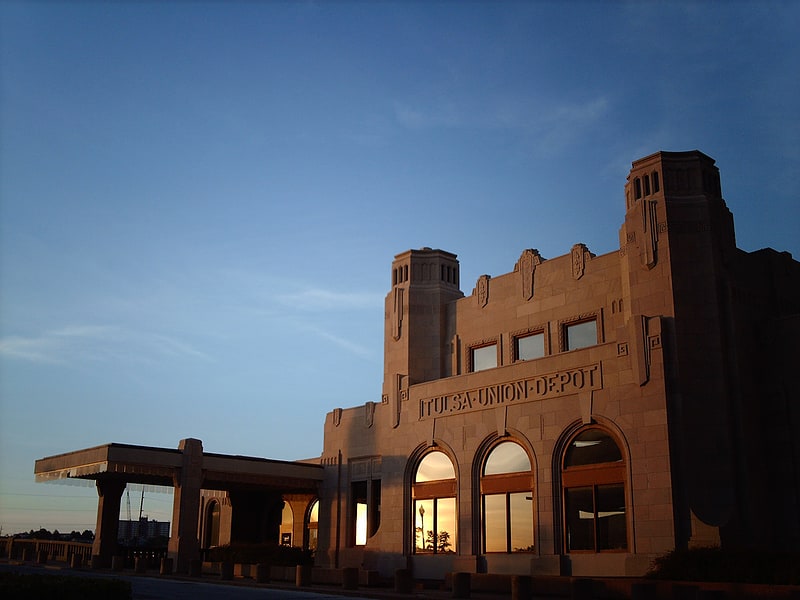
Museum in Tulsa, Oklahoma. The Oklahoma Jazz Hall of Fame, located in Tulsa, Oklahoma, is a non-profit organization that honors jazz, blues and gospel musicians in the state of Oklahoma. Housed in the former Tulsa Union Depot, which it now calls the Jazz Depot, the Hall of Fame is a music venue that hosts regular jazz performances. It is also a museum, displaying photographs, biographical information, artifacts, and memorabilia from musicians such as Chet Baker, Earl Bostic, Barney Kessel, Charlie Christian, Tommy Crook, Pat Kelley, and Jimmy Rushing.[14]
Address: 111 E 1st St, 74103-2816 Tulsa
The Outsiders House Museum
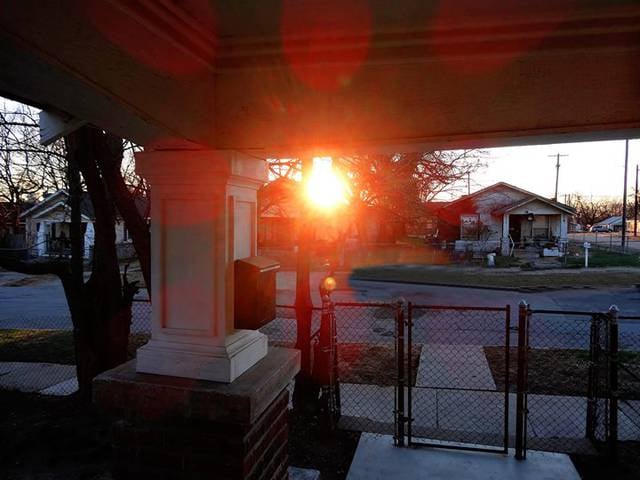
The Outsiders House Museum is a museum in Tulsa, Oklahoma, about the 1983 coming-of-age movieThe Outsiders, the 1967 novel by the same name it adapts to the screen and its author S. E. Hinton. It aims to preserve the home who served as primary film set for the Curtis Brothers' home. The museum was created by hip-hop artist Danny Boy O'Connor. A long-time fan of The Outsiders, O'Connor bought the house in 2015. After extensive renovations to restore and maintain its authenticity from the film, it opened on August 9, 2019.[15]
Address: 731 N. St. Louis, Tulsa (Northside)
Tulsa Art Deco Museum
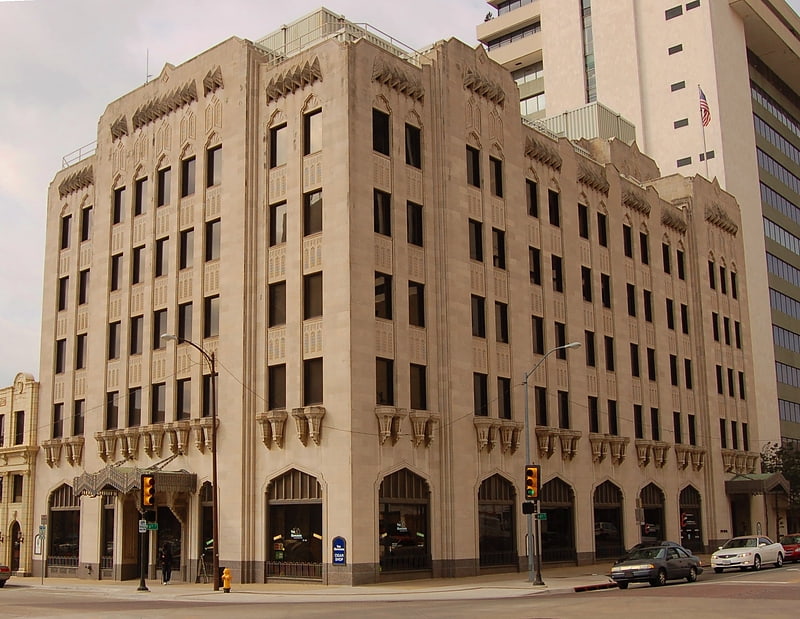
Apartment building in Tulsa, Oklahoma. In 1899, the Vinita Electric Light, Ice and Power Company, which was headquartered in the Indian Territory town of Vinita obtained a charter to provide electric power to that community. In 1913, the company consolidated with similar independent companies in Tulsa, Guthrie, Coalgate, Lehigh and Atoka to form a new company, named Public Service Company of Oklahoma. The founder and first president of PSO was Frederick William "Fred" Insull, who moved the company's headquarters to Tulsa in 1916.
The Public Service Co. of Oklahoma Building, originally completed in 1929, was the headquarters of the electric service utility in Tulsa, Oklahoma, Public Service Co. of Oklahoma (PSC). It was known by that name until its owner (then known as PSO) was acquired by Central & Southwest Corporation (CSC), a major utility holding company, when the building was renamed as the PSO Building. CSC was later acquired by a larger holding company, American Electric Power Company, which retained PSO as an operating company serving customers in the state of Oklahoma. It was listed on the National Register of Historic Places (NRIS #84003443) on April 10, 1984. It was added as a Contributing Property to the Oil Capital Historic District in 2010.
PSO vacated this building and sold it to a California real estate investor in 2005. PSO then moved its personnel to the former Central High School building in downtown Tulsa, moves which were completed in 2007. The investor, Maurice Kanbar held the building until 2012, when he sold it, as part of a package, to Stuart Price, one of his associates. The new owner decided to repurpose the building from corporate offices to luxury apartments, and spent several years thoroughly renovating the interior. He also renamed the building Art Deco Lofts and Apartments. Apartment buyers began moving into the building in mid 2016.[16]
Tulsa Zoo
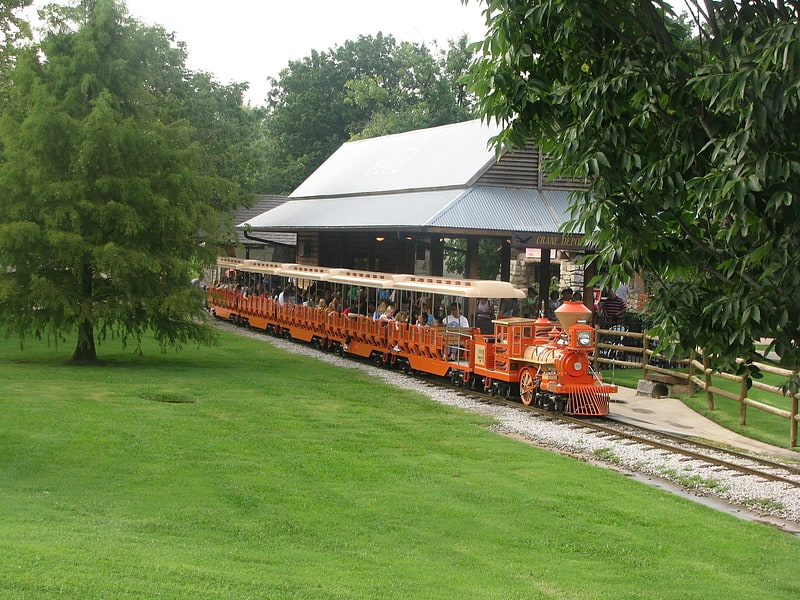
Zoo in Tulsa, Oklahoma. The Tulsa Zoo is an 85-acre non-profit zoo located in Tulsa, Oklahoma, United States. The Tulsa Zoo is owned by the City of Tulsa, but since 2010 has been privately managed by Tulsa Zoo Management, Inc. The zoo is located in Mohawk Park, one of the largest municipal parks in the United States.
The zoo is involved in many conservation efforts, such as a push to reduce the use of palm oil, FrogWatch USA, and efforts to encourage ocean conservation.
The Tulsa Zoo is accredited by the Association of Zoos and Aquariums.[17]
Address: 6421 E 36th St N, 74115 Tulsa (Northside)
Golden Driller
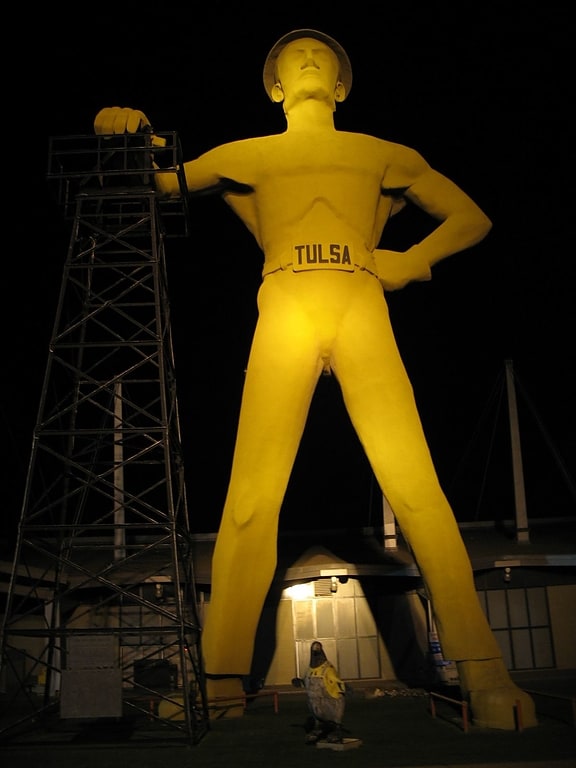
Statue created in 1953. The Golden Driller is a 75-foot-tall, 43,500-pound statue of an oil worker, in Tulsa, Oklahoma. The structure is a steel frame covered with concrete and plaster. It is the sixth-tallest statue in the United States and has been located in front of the Tulsa Expo Center since 1966.[18]
Address: 4145 E 21st St, 74114-2108 Tulsa (Midtown)
Pythian Building
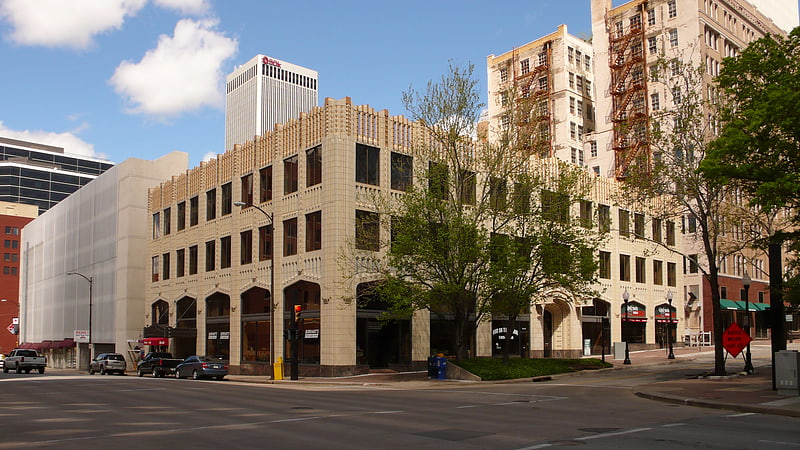
The Gillette-Tyrrell Building is a building in downtown Tulsa, Oklahoma. It was begun in 1929 by two Tulsa oilmen, J. M. Gillette and H. C. Tyrrell. They initially planned to construct a three-story office building at 432 S. Boulder Avenue, topped by a ten-story hotel, but these plans were canceled during the Great Depression and they stopped construction at the third floor. In 1931, they sold it to the Knights of Pythias, who decided to complete it as an office building and renamed it the Pythian Building.
The building was added to the National Register of Historic Places (NRHP) on January 21, 1982 (NRIS #82003703). The application lists its architecture as a mix of the Art Deco styles: Modern and Zig Zag. It is also listed as a contributing property on the NRHP Application for the Oil Capital Historic District (NRIS #10001013).[19]
Turkey Mountain Urban Wilderness Area

Turkey Mountain Urban Wilderness Area is a 300-acre area of undeveloped land that stretches from I-44 to 71st Street in Tulsa in the US state of Oklahoma. It is managed by the Tulsa River Parks Authority and open to the public. The main entrance to the wilderness area is at 67th Street and Elwood Avenue in West Tulsa.[20]
First Presbyterian Church

Presbyterian church in Tulsa, Oklahoma. The First Presbyterian Church of Tulsa was organized in 1885 in Creek Nation, Indian Territory, before statehood. It originally met in the store owned by brothers James M. Hall and Harry C. Hall, and was served by itinerant, circuit-riding ministers.
Its first building was wooden, built in 1899. The first permanent minister, Reverend Charles William Kerr and his wife arrived in Tulsa in 1900. Kerr served at this church for more than 40 years. Under his leadership, two more church buildings were constructed, each of stone.
As Tulsa developed as a major city after the early 20th-century oil boom here, this church's congregation grew to become in 1948 the second-largest Presbyterian congregation in the country. FPC is part of the Eastern Oklahoma Presbytery of the United Presbyterian Church in the USA (UPCUSA).
During the Tulsa Race Riot of 1921, Rev. Kerr offered church spaces as refuge to African Americans, mostly women and children fleeing the violence and widespread destruction of whites attacking their Greenwood District. The 1926 church is considered a contributing structure to the city's Oil Capital Historic District, which was listed on the National Register of Historic Places in 2010.[21]
Address: 709 S Boston Ave, 74119 Tulsa
11th Street Bridge

Bridge in Tulsa, Oklahoma. The 11th Street Bridge was completed in December 1915 to carry vehicles across the Arkansas River at Tulsa, Oklahoma. Used from 1916 to 1972, it was also a part of U.S. Route 66. Functionally, it has been replaced by the I-244 bridges across the Arkansas. At present, the bridge is in poor structural condition and unsafe even for pedestrians. In 2008, the gates were locked to exclude all visitors.
This bridge was added on December 13, 1996, to the National Register of Historic Places under Criteria A and C. Its NRIS number is 96001488. It was named the "Cyrus Avery Route 66 Memorial Bridge" in 2004.
Although the bridge still stands, it is considered unsafe for use and has been closed to vehicles since 1980 and to pedestrians since 2008.[22]
Address: Old 11th St Bridge, Tulsa (Midtown)
Tulsa Theater

Theater in Tulsa, Oklahoma. The Tulsa Theater is a theater and convention hall located in Tulsa, Oklahoma. It was originally completed in 1914 and remodeled in 1930 and 1952. The building was used as a detention center during the 1921 Tulsa race massacre. It is listed on the National Register of Historic Places and remains in use as a theater today. The theater was previously named after W. Tate Brady but was renamed in 2019 due to Brady's affiliation with the Ku Klux Klan.[23]
Address: Tulsa, 105 Reconciliation Way, Tulsa, OK 74103-7809
Mount Zion Baptist Church
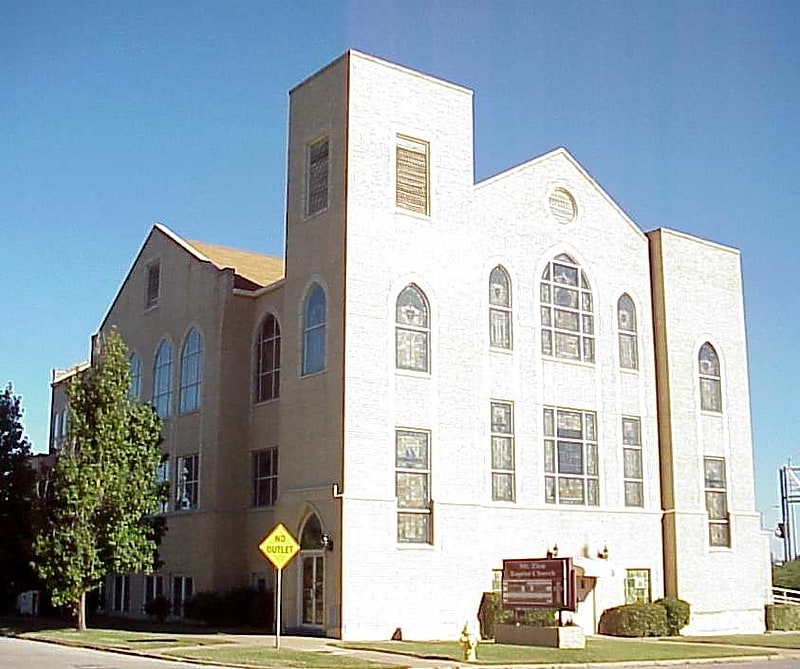
Building. Mount Zion Baptist Church is a historically significant church in the Greenwood District of Tulsa, Oklahoma. It was listed on the National Register of Historic Places on September 5, 2008. The original building was burned during the Tulsa race massacre on June 1, 1921. According to the Tulsa Preservation Commission, ".. Mount Zion Baptist Church remains a testimony to the perseverance and tenacity of its congregants and the black community in Greenwood." The church building was rebuilt in 1952 on its original site.[24]
Address: 419 N Elgin Ave, 74120-1016 Tulsa (Northside)
Woody Guthrie Center
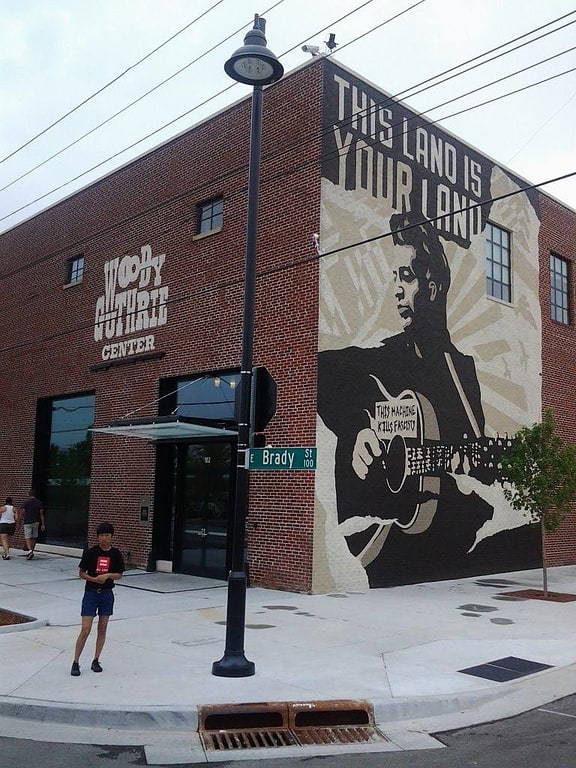
Museum in Tulsa, Oklahoma. The Woody Guthrie Center is a public museum and archive located in Tulsa, Oklahoma that is dedicated to the life and legacy of American folk musician and singer-songwriter Woody Guthrie. The Center also contains the archives of folk singer, songwriter, and fellow social activist Phil Ochs.[25]
Address: 102 E Brady St, 74103-2014 Tulsa
Prayer Tower

Tower in Tulsa, Oklahoma. The Prayer Tower is a late Googie design-influenced tower located on the campus of Oral Roberts University in Tulsa, Oklahoma. The 200 ft glass and steel structure, designed by Tulsa architect Frank Wallace, opened in 1967. An enclosed observation deck gives a 360° view of the surrounding area and enables a self-guided visual tour of the ORU campus. The landscaped Ralph L. Reece Memorial Gardens surround the tower base. The tower is a popular local tourist attraction.[26]
All Souls Unitarian Church
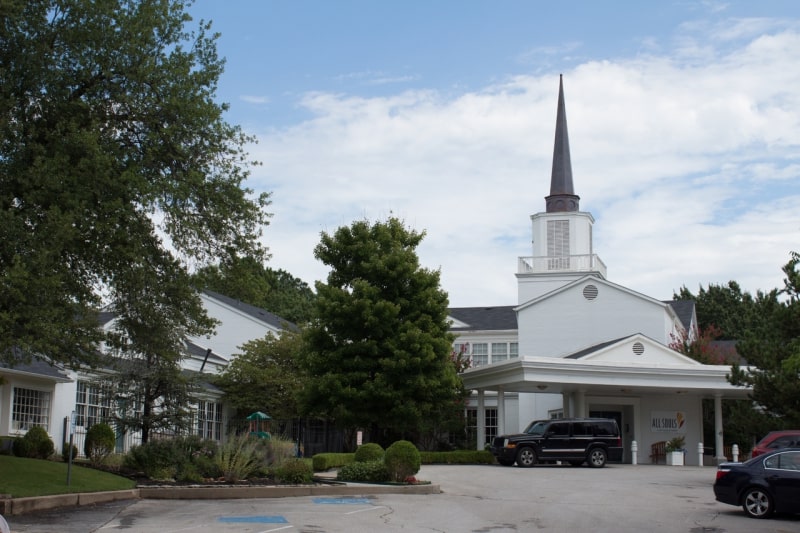
Unitarian universalist church in Tulsa, Oklahoma. All Souls Unitarian Church is a Unitarian Universalist church in Tulsa, Oklahoma. It is one of the largest UU congregations in the world.
All Souls Unitarian Church was founded in 1921 by two leading Tulsans from families with Unitarian roots: Richard Lloyd Jones, the publisher of the Tulsa Tribune daily newspaper, whose father, Rev. Jenkin Lloyd Jones, had served as secretary of the Western Unitarian Conference and founded All Souls Church in Chicago; and William Rea (W. R.) Holway, an engineer who was instrumental in the development of Tulsa's water resources.[27]
Address: 2952 S Peoria Ave, 74114 Tulsa (Midtown)
Tulsa Historical Society & Museum
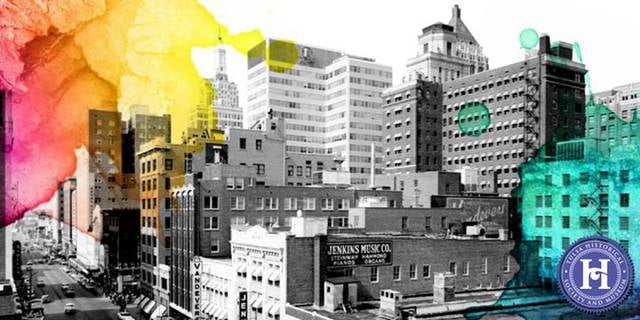
Museum, History museum
Address: 2445 S Peoria Ave, 74114-1326 Tulsa (Midtown)
Creek Council Oak Tree
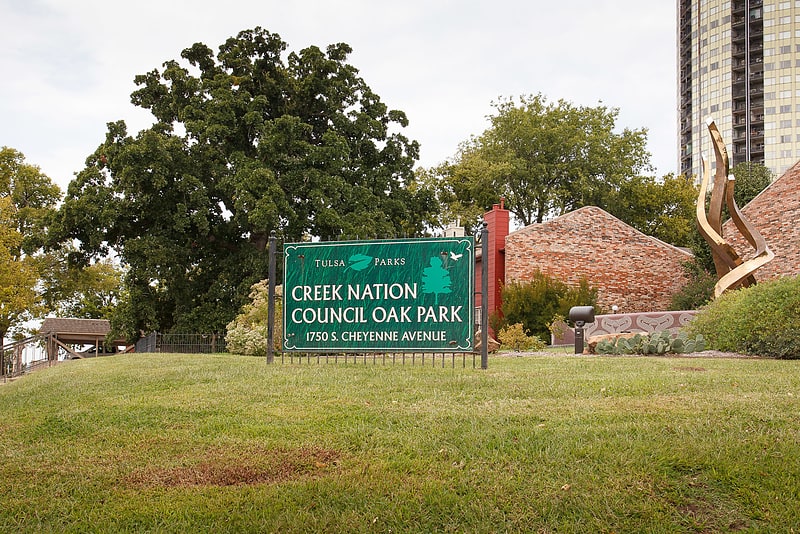
The Creek Council Oak Tree is a historic landmark which represents the founding of the modern city of Tulsa, Oklahoma, United States by the Lochapoka Tribal Town of the Creek Nation.
The Creeks had been forced to leave their homeland in the southeastern United States and travel to land across the Mississippi River, where the U.S. Government had granted them land in what was then known as Indian Territory. In 1836, after their arrival, the Lochapokas chose an oak tree on top of a hill that overlooked the Arkansas River as the site of their council ground. They lit a new ceremonial fire, using coals they had carried on their journey, established a busk ground, where all council business would be conducted. These grounds were also a gathering place for tribal ceremonies, feasts and games. The site continued to be used for these events until 1896. The Creeks still hold an annual celebration of their arrival at this site on October 20.[28]
Address: 18th St. and Cheyenne Ave, Tulsa (Midtown)
I-44 Antique Mall
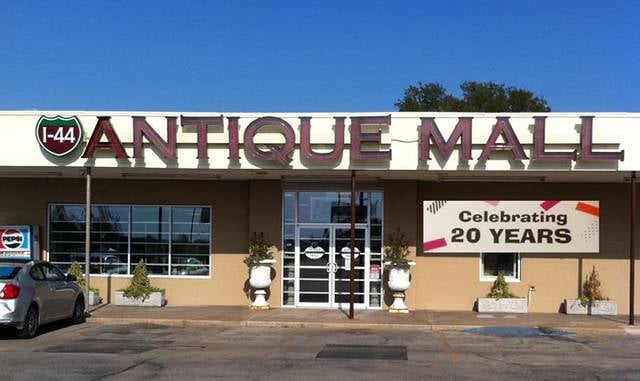
Shopping, Shopping centre, Antiques, Flea market
Address: 5111 S Peoria Ave, 74105-5620 Tulsa (Southside)
Philtower
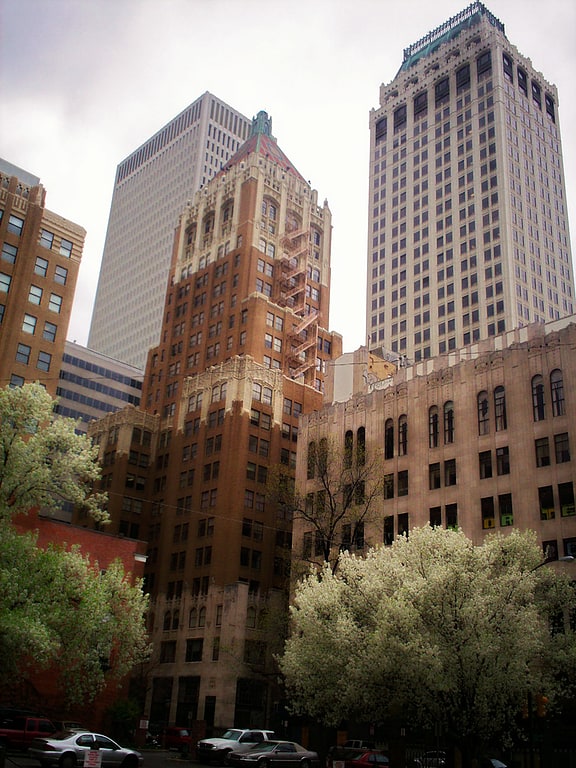
Building in Tulsa, Oklahoma. The Philtower Building is a historic building located at 427 South Boston Avenue in Tulsa, Oklahoma.[29]
Address: 427 S Boston Ave, 74103-4141 Tulsa
Oklahoma State University–Tulsa
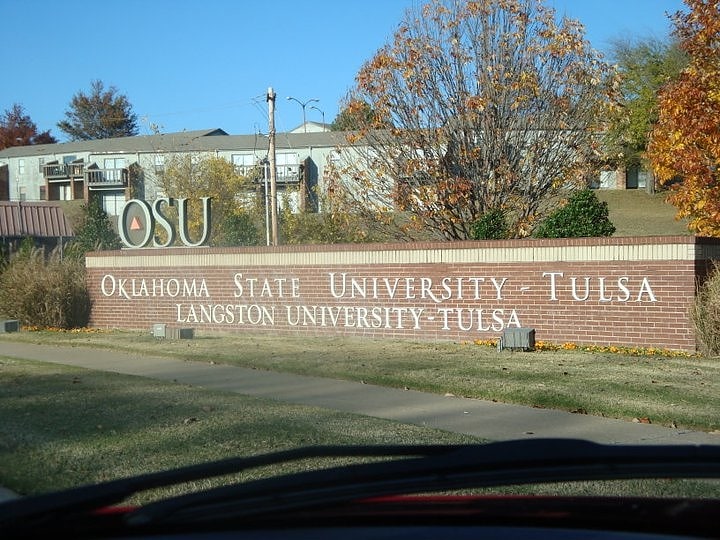
University in Tulsa, Oklahoma. Oklahoma State University–Tulsa, located in Tulsa, Oklahoma, United States, is the newest institution of the Oklahoma State University System. It was previously the University Center at Tulsa until it became OSU-Tulsa on January 1, 1999. OSU-Tulsa is unique in the fact that it is not recognized as its own entity, but rather an extension of the main Oklahoma State University campus in Stillwater, Oklahoma. OSU-Tulsa works in conjunction with the main OSU campus and Tulsa Community College to provide Freshman and Sophomore level courses, enabling students to complete a four-year undergraduate course of study. Pamela Martin Fry was named the institution's third president and first female president in 2019.[30]
Address: 700 N Greenwood Ave, 74106-0702 Tulsa (Northside)
320 South Boston Building
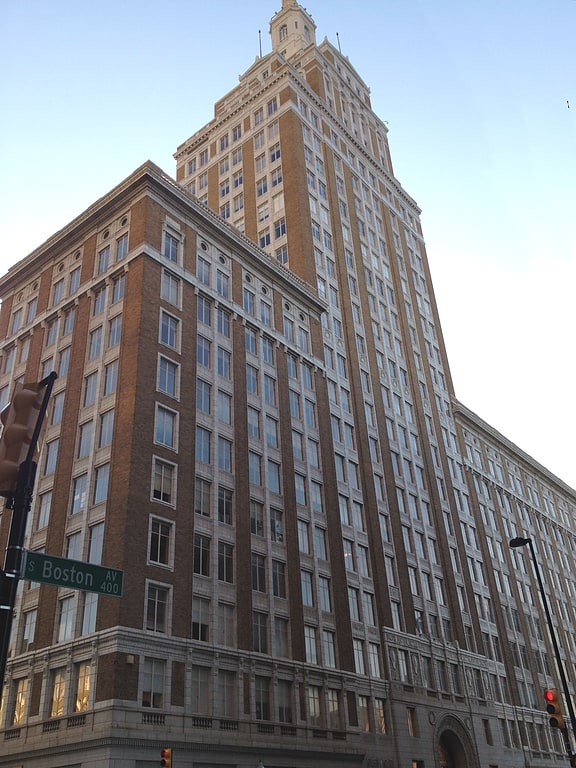
High-rise building in Tulsa, Oklahoma. The 320 South Boston Building is a 22-story high-rise building located in downtown Tulsa, Oklahoma. It was originally constructed at the corner of Third Street and Boston Avenue as a ten-story headquarters building for the Exchange National Bank of Tulsa, Oklahoma in 1917, and expanded to its present dimensions in 1929. The addition brought the building's height to 400 feet, making it the tallest building in Oklahoma. It lost this distinction in 1931, but remained the tallest building in Tulsa until Fourth National Bank was completed in 1967. It is now included in the Oil Capital Historic District.[31]
Address: Tulsa, 320 South Boston
SageNet Center
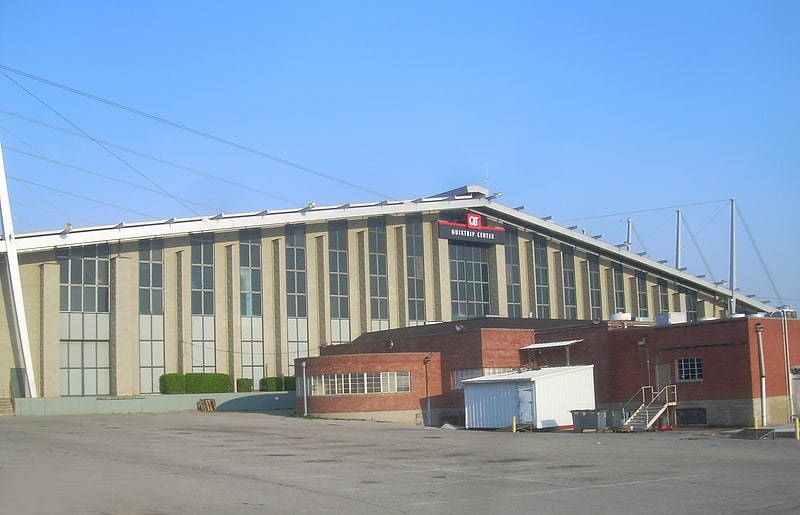
Event venue in the Tulsa County, Oklahoma. SageNet Center, originally known as the Exposition Center from 1966 to 2007 and QuikTrip Center, until 2012, and River Spirit Expo from 2013 to 2021, is the center of the Tulsa State Fair and one of the largest clearspan buildings in the world. The Expo Center provides 354,000 square feet of column-free space under a cable-suspended roof. The building spans 448,400 total square feet on two levels, connected by side ramps and stairs, allowing for a variety of show floor plans.[32]
Address: 4145 E 21st St, 74114-2108 Tulsa (Midtown)
BOK Tower
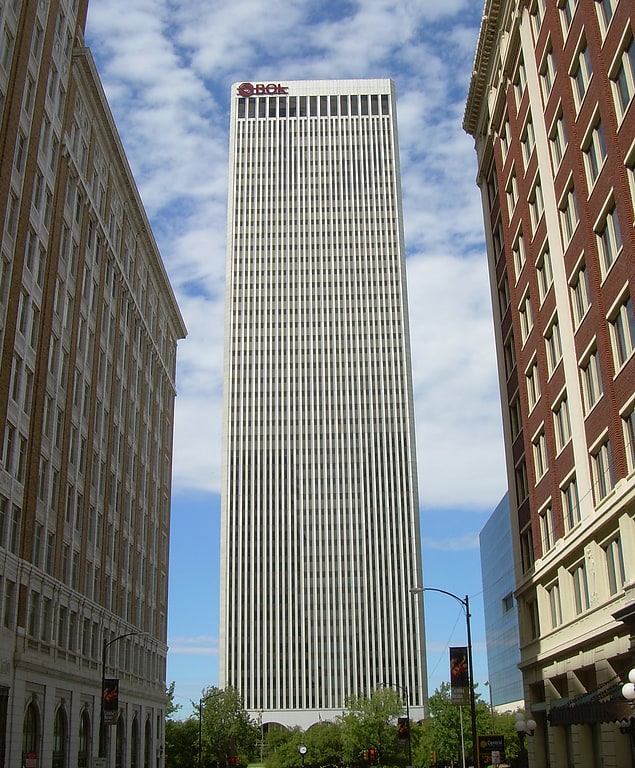
Skyscraper. BOK Tower is a skyscraper in Downtown Tulsa, Oklahoma. At 203 m in height, the 52-story tower was the tallest building in Oklahoma until surpassed by Devon Tower in 2011. It was built in 1976 and designed by Minoru Yamasaki & Associates, the same architect who designed the World Trade Center's Twin Towers in New York City. This structure is very similar to the WTC towers in appearance and construction.[33]
Address: E 2ND St S, Tulsa